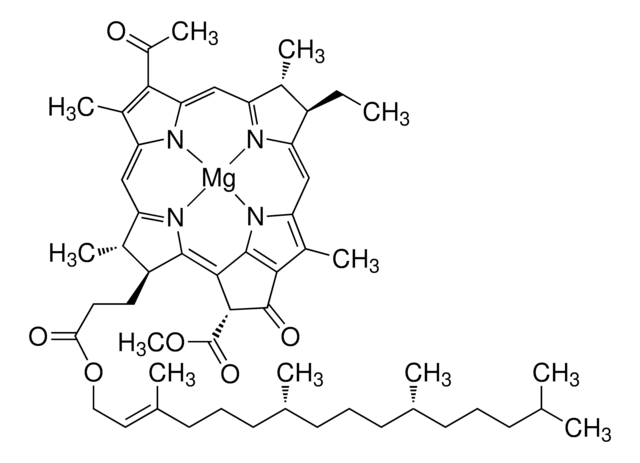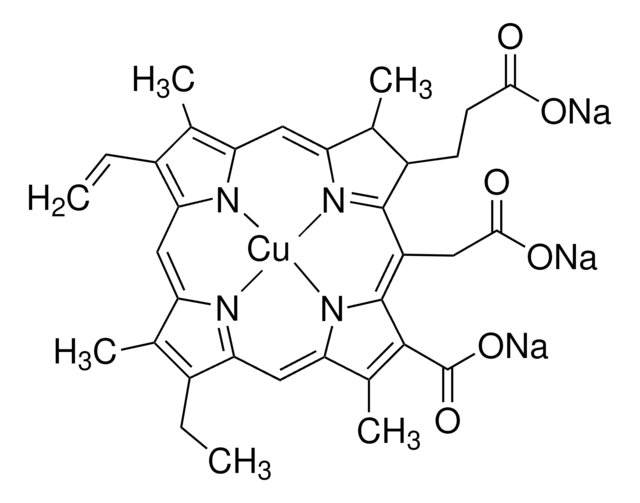The recommended storage conditions and periods for the stock solution are:
• - 80 ℃ for 6 months
• - 20 ℃ for 1 month.
C6144
Chlorophyll a
Powder
Sinónimos:
Pheophytin; universal photosynthetic pigment
Seleccione un Tamaño
About This Item
Productos recomendados
Nombre del producto
Chlorophyll a, from Anacystis nidulans algae
biological source
Anacystis nidulans algae
Quality Level
form
powder
technique(s)
titration: suitable
impurities
chlorophyll b, free
color
blue to very dark blue
mp
150-153 °C
solubility
diethyl ether: 0.1 mg/10 mL
ε (extinction coefficient)
11.1-12.1 × 104 at 428-430 nm in diethyl ether
8.3-9.4 × 104 at 660-662 nm in diethyl ether
application(s)
diagnostic assay manufacturing
hematology
histology
storage temp.
−20°C
SMILES string
CCc1c(C)c2cc3c(C=C)c(C)c4cc5nc([C@@H](CCC(=O)OC\C=C(/C)CCC[C@H](C)CCC[C@H](C)CCCC(C)C)[C@@H]5C)c6[C@@H](C(=O)OC)C(=O)c7c(C)c(cc1n2)n([Mg]n34)c67
InChI
1S/C55H73N4O5.Mg/c1-13-39-35(8)42-28-44-37(10)41(24-25-48(60)64-27-26-34(7)23-17-22-33(6)21-16-20-32(5)19-15-18-31(3)4)52(58-44)50-51(55(62)63-12)54(61)49-38(11)45(59-53(49)50)30-47-40(14-2)36(9)43(57-47)29-46(39)56-42;/h13,26,28-33,37,41,51H,1,14-25,27H2,2-12H3,(H-,56,57,58,59,61);/q-1;+2/p-1/b34-26+;/t32-,33-,37+,41+,51-;/m1./s1
InChI key
ATNHDLDRLWWWCB-AENOIHSZSA-M
¿Está buscando productos similares? Visita Guía de comparación de productos
Application
Biochem/physiol Actions
Packaging
Storage Class
11 - Combustible Solids
wgk_germany
WGK 3
flash_point_f
Not applicable
flash_point_c
Not applicable
ppe
Eyeshields, Gloves, type N95 (US)
Elija entre una de las versiones más recientes:
¿Ya tiene este producto?
Encuentre la documentación para los productos que ha comprado recientemente en la Biblioteca de documentos.
Los clientes también vieron
-
What is the recommended storage method for item C6144, (Chlorophyll a) stock solutions?
1 answer-
Helpful?
-
-
Can Product C6144, Chlorophyll a, be used as an analytical standard?
1 answer-
We do not recommend using this product as a standard. The fill weights of 1 mg and 5 mg are minimum values and are not guaranteed to a specific precision. Also, the product is not traceable to a consensus standard reference material.
Helpful?
-
-
Is Product C6144, Chlorophyll a, soluble in solvents other than diethyl ether?
1 answer-
This product is soluble in ethanol (10 micrograms/mL). It is also freely soluble in acetone, benzene, and chloroform, but is not soluble in water. However, its spectral characteristics are most well characterized for solutions in diethyl ether.
Helpful?
-
-
What is the Department of Transportation shipping information for this product?
1 answer-
Transportation information can be found in Section 14 of the product's (M)SDS.To access the shipping information for this material, use the link on the product detail page for the product.
Helpful?
-
-
How does chlorophyll a from blue green algae differ from that found in plants?
1 answer-
A complete analysis of chlorophyll a between species would require extensive study. We can say that the CAS number of this product is the same as that for chlorophyll a from spinach, a typical green plant.
Helpful?
-
-
What is the purity of Product C6144, Chlorophyll a, as determined by chromatographic analysis (e.g., by HPLC)?
1 answer-
We do not determine the purity of Product No. C6144 by chromatographic means. We offer an HPLC tested Chlorophyll a (isolated from spinach) as Product no. C5753.
Helpful?
-
Active Filters
Nuestro equipo de científicos tiene experiencia en todas las áreas de investigación: Ciencias de la vida, Ciencia de los materiales, Síntesis química, Cromatografía, Analítica y muchas otras.
Póngase en contacto con el Servicio técnico







